How the Tesla Semi Truck Will Impact the Car Shipping Industry
Tesla has so far introduced some revolutionary all-electric vehicles that have shaken the transportation industry and thrilled fans all around the globe. However, the all-electric Tesla Semi Truck brings something completely different to the table. Unveiled by CEO Elon Musk in November 2017 at Tesla’s facility in Hawthorne, California, the Semi is a Class 8 heavy-duty truck that’s set to transform the shipping industry. The new Tesla Semi Car Hauler follows the same technologies as are available in Tesla’s previous designs, such as semi-autonomous driving, an impressive single-charge range, and impeccable safety features – except now they’re on an 80-thousand-pound hauler.
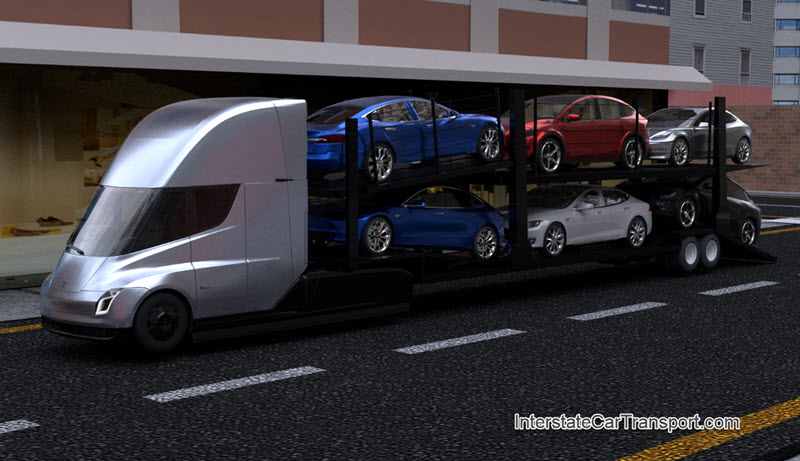
Right after the announcement of Tesla Semi, the company started taking orders for the truck and declared that the production will start in 2019 at its Nevada factory. Some companies in the commercial trucking business, such as Walmart, Pepsi, and FedEx, really liked this semi hauler and pre-ordered the truck. However, later Tesla stated that the production will not start until 2020. On top of delayed production, Tesla announced to manufacture only a few Tesla Semi electric trucks in 2020.
There has been no news confirming that the Semi is in production yet. It has undoubtedly left us wondering whether we’ll soon see a fleet of Tesla’s all-electric haulers on the highway, or if the Semi Truck is actually dead?
Tesla has been dealing with production and supply chain hurdles revolving around the Model 3 Sedan, which essentially caused the delays in Tesla Semi Truck production. Even then, Tesla is claiming that the hauler is currently under development. You might be wondering whether this is true or not – a few pieces of evidence indicate Tesla’s claims just might be real.
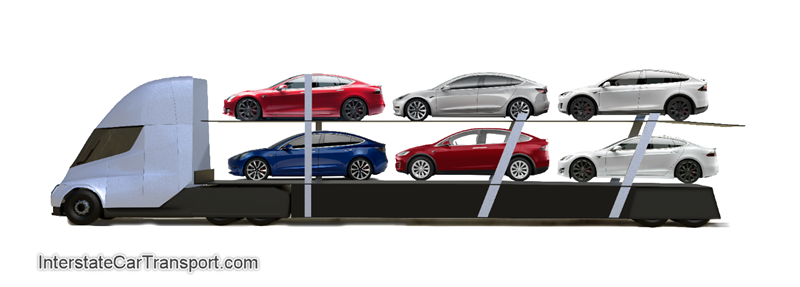
Tesla has a new building next to Gigafactory Nevada where they have recently started operations. Although it isn’t clear yet what the company is doing in the massive building, it may be the production of the all-electric Semi.
Regardless of where Tesla plans to build its electric Semi, we know development is in process. Throughout last year, we saw videos and pictures, showing the Tesla Semi Truck in the wild in full action. In February 2019, the California Highway Patrol photographed a bright red Semi Truck hauling an alleged test payload of 75,000-pounds. Soon spotting Tesla Semis transporting Tesla cars will become commonplace.
While it might take until the second half of 2020 to begin the manufacturing of these all-electric haulers, some serious testing is underway. So, worry not because this electric Semi truck is very much alive – and it’s quite an impressive machine. What makes the Telsa Semi Car Hauler stand out from the rest? Is it the sleek, ultra-modern exterior, the roomy, futuristic driver’s cabin, incredible acceleration, and range, or something else?
But first – what’s the motivation behind the Tesla Semi? Does it connect to the company’s ongoing distribution problem? Let’s explore:
Tesla to Solve Distribution Problems
At the beginning of 2019, Tesla acquired Central Valley Transport’s trucks in an attempt to improve their delivery processes. The company’s delivery logistics scheme was in trouble, likely due to the Model 3 was not being produced at scale. Perhaps, that’s one of the reasons. However, Tesla’s delivery logistics business model might have been in trouble to begin with. It operates its own service centers, delivery centers, and stores without any third-party involvement. Tesla takes responsibility for each vehicle up until it reaches the customer. Though that might’ve worked in the beginning, over time, keeping up with production demands became challenging. With automakers who sell their cars to dealers, there’s a whole lot of inventory that they get to offload. Tesla, on the other hand, doesn’t have this option, and that contributed to logistics problems.

Toward the end of 2019, it was no secret that Tesla was still facing delivery issues. The company couldn’t keep up with delivering cars to the respective delivery centers on time. But as usual, Musk was already ahead of the problem. First, he proposed that Tesla’s vehicle should be sent off as soon as someone ordered them, so they sit at delivery centers rather than taking up space at the factory – something the company wasn’t doing before. Previously, Tesla wouldn’t send a vehicle unless the customer was ready to pick up the car.
Musk also stated that the company even started producing its own vehicle carriers so they can move more cars. And there it was – one of the biggest motivations (apart from contributing toward a more sustainable future, of course) for the Tesla Semi. Building and using their own trucks means many things for the company, all of them positive.
Tesla’s very own all-electric Semi distribution system means the company can increase deliveries and save money as well. Plus, they wouldn’t have to reach out to a third-party to help them improve delivery logistics and responsibility for distribution would remain within the company.
Sounds promising for Tesla, right? But at the same time, the company faces multiple challenges regarding Tesla Semi Truck production. Before diving into those challenges, it’s important to understand the heavy-duty truck’s specifications and features first.
Tesla Car Hauler Specs
The Tesla Semi car hauler isn’t only a marvel to look at – its high tech specifications will also blow you away. With a maximum speed of 100 mph, the all-electric giant has four independent motors on its rear axles and an energy consumption rating of fewer than 2 kWh per mile.
The truck can carry up to six cars, and when loaded with six Teslas on a trailer, its Full Gross Vehicle Weight (GVW) is less than 80,000 pounds. Yes, this neat and sleek truck can haul that much maximum weight. But it doesn’t end there.
Even at full weight capacity, the Tesla Semi car hauler accelerates from zero to sixty in 20 seconds. For a truck dragging around so much weight, it appears too good to be true.
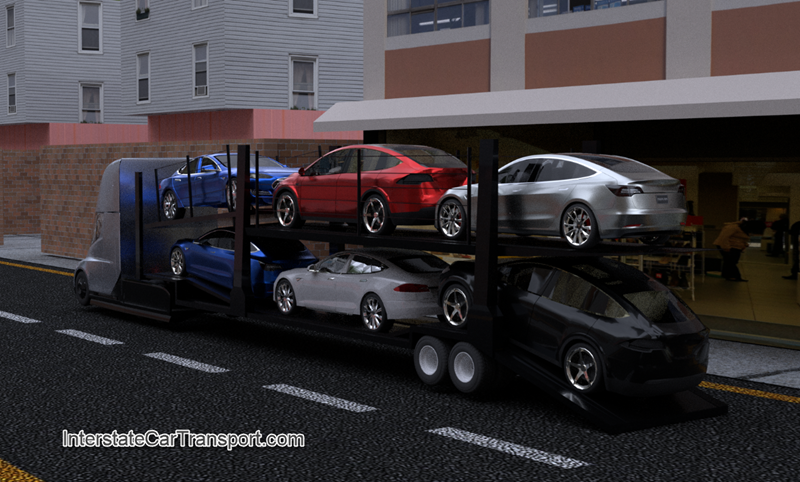
But what about the truck’s range? After all, that’s what really matters in an electric vehicle, right? The Tesla Semi comes in two variations – one with a 300-mile range, and the other with a 500-mile range. What’s more, is that Tesla’s upcoming Megacharger technology will be able to give up to 400 miles of range in only thirty minutes.
On the other hand, an unloaded Tesla Semi Truck takes about 6.5 seconds to go from zero to sixty and offers 620 miles of range. Unfortunately, we don’t know the hauler’s deceleration specs so far, and its dimensions haven’t been disclosed yet either.
Tesla Semi Car Hauler Features
Tesla has always prioritized vehicle safety and with a truck that can haul tens of thousands of pounds of weight, it’s no surprise that Tesla Semi development engineers have loaded it with state-of-the-art safety technology. It boasts standard automatic emergency braking, lane-keeping assist, forward collision warning, and an impact-resistant glass windshield. The truck also includes Enhanced Autopilot technology that helps prevent collisions.
Tesla comments that the Semi hauler is safer than other semis in the market mainly because of its reinforced, floor-mounted battery. Its lower position on the truck reduces the vehicle’s center of gravity, decreasing the likelihood of a rollover. The Tesla Semi’s wheels have separate, independent motors, which mean independent torque distribution for each motor. On board sensors detect instability and adjust the torque according to each wheel, and at the same time, they activate all brakes. This considerably lowers the risk of jackknifing that can cause a serious accident.
The truck driver’s seat is located in the center of the cabin, and though the position is quite out of the ordinary, it means the driver will have maximum control and visibility. Plus, cameras outside the Tesla Semi assist in detecting blind spots and alert the driver when a dangerous situation arises.
Let’s not forget the Tesla Semi’s regenerative braking, where the energy wasted while applying the brakes turns into useful energy instead. The regenerative braking system stores it as kinetic energy that the truck can use instantly or store it for later use. It’s not the first time we’re seeing this concept – Tesla uses it on its other vehicles, as well.
As for the interior, the Tesla Semi car hauler’s cab design caters specifically to the driver’s comfort, accessibility, and even luxury. The sleek, minimalist cabin offers enough space inside for the driver to stand in, and it features two touchscreen displays on either side of the centrally positioned driver’s seat.
Last but not least, to end the enduring curiosity about the truck’s sleeper area – it doesn’t have one. Tesla has removed a bunch of traditional Semi features from this all-electric truck, one of them being the sleeper. The Tesla Semi car hauler is essentially a “day truck” or “day cab,” and since its range is intended for smaller routes, so it shouldn’t be a huge setback.
Sooner or later, all-electric Semi models devised for longer trips might have a designated sleeping area. According to Mashable, Tesla’s designers are considering a future Tesla Semi Sleeper Cab model. The company says they would extend the cabin’s length, but the overall length of the Semi will remain the same. When exactly this will happen, nobody knows yet. But one thing we know for sure is that just like every Tesla Semi’s neat features, it will be extraordinary.
Tesla Semi Car Hauler Costs
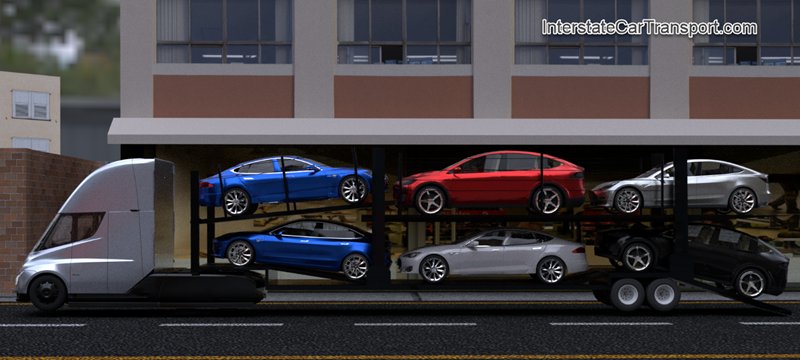
With a truckload of highly advanced features and all-around impressive specs, you can’t help but wonder whether you might end up paying an arm and a leg for the Tesla Semi truck. Understand, the currently expected price ranges aren’t all that bizarre.
The projected cost for the 300-mile range Tesla Semi Car hauler without any trailer attached is $150,000. For the base 500-mile range truck without the trailer, the price is $180,000. You can make a $5,000 reservation on Tesla’s website for either of the trucks. The cost for a Tesla Semi car hauler with an attached trailer is not yet known.
Are these anticipated price ranges justified? Well, maybe a look at some similar trucks in the market along with their major specs and features will help determine whether the Tesla Semi is, in fact, worth the initial investment.
The Tesla Semi Car Hauler Isn’t Alone
When it comes to all-electric truck technology, the Tesla Semi sure has a lot of competition. Knowing that the future is electric, a bunch of major truck manufacturers have gotten on board and started revealing their own all-electric giants. Some of these companies include Daimler Trucks North America, Volvo, Paccar, Volkswagen, and even Cummins.
What do these other heavy trucks have in store for us? And how do they equate with the Tesla Semi? Here are a few comparisons:
Tesla Semi Vs. Nikola One
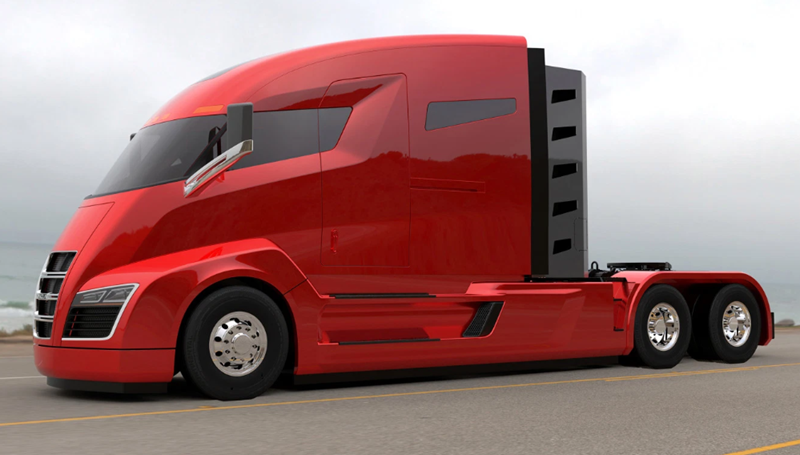
Nikola Motors is an Arizona-based start-up that isn’t entirely focused on all-electric heavy-duty vehicles, rather they create hydrogen-electric vehicles. The manufacturer designs fuel-cell electric trucks that deploy hydrogen fuel cell technology instead of using grid-charged batteries to run the electric motors. The one major advantage they get from this technology is an improved range. Nikola plans to develop all-electric alternatives as well for those who require trucks with less range for shorter routes.
Many of the companies ordering Tesla Semi haulers may buy Nikola’s trucks too. Nikola One’s higher 500 to 750-mile range could be more appealing to customers. The truck can also haul the same amount of GVWR as the Tesla Semi (80,000 pounds). However, there’s one place where the Nikola One falls short – zero to sixty acceleration. The hydrogen-electric hauler takes 30 seconds to reach from zero to sixty mph, while the Tesla Semi only takes 20.
Tesla Semi vs. eCascadia
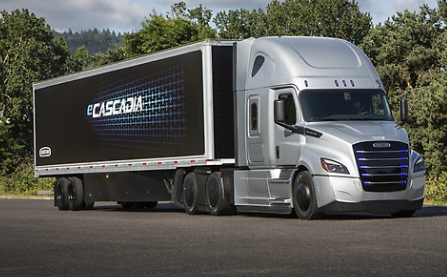
The eCascadia all-electric truck is developed by Freightliner, the Semi truck brand owned by Daimler Trucks North America. Daimler is one of the biggest truck makers in the world, and when they felt pressure from Tesla’s all-electric Semi, they launched their own too. While the eCascadia plans to compete with Tesla’s all-electric Semi, the real question is how good is Daimler’s truck? While the eCascadia matches the Tesla Semi truck’s size and capacity, it has a considerably lower range. The eCascadia can go 250 miles as compared to the Tesla Semi’s 500-mile range. Daimler’s all-electric, however, can handle the same amount of GCWR as the Tesla Semi car hauler.
Tesla Semi vs. Volvo All-Electric Tractor
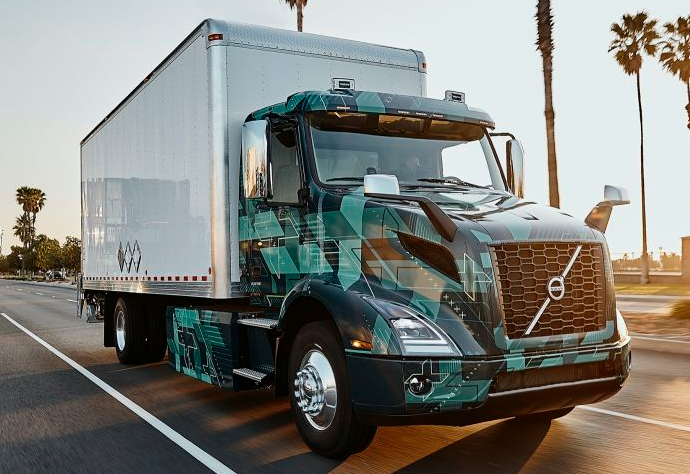
Volvo has been building semi trucks in the U.S. for nearly 100 years, and now they’ve come forward with an all-electric vehicle. This electric tractor is part of Volvo’s LIGHTS (Low Impact Green Heavy Transport Solution) program and is most suitable for local, very short hauls. It has a range of 75 to 175 miles and a GCWR of 66,000 pounds. The weight of the truck itself accounts for a large part of its gross weight, causing it to limit the amount of mass you can attach and lug around.
And that’s how the Tesla Semi car hauler measures up to some of its major competitors. Tesla’s all-electric truck seems to have one main specification point that stands out from nearly all other similar trucks in the market – it’s staggeringly quick acceleration rate.
However, we’ve heard and read countless predictions all around that Tesla may not be able to live up to their claims of these too-good-to-be-true specifications. This brings us to some imperative technology challenges the company faces with the development of the Tesla Semi truck.
Technology Challenges with the Tesla Semi
To begin with, Tesla states that their electric Semi will go up to 500 miles at highway speed and fully loaded capacity. Now, this is a huge deal – if only developers can pull it off. But there’s been some concern, especially from Carnegie Mellon researchers, about how the truck will support a 500-mile range without development costs skyrocketing.
As the electric battery’s capacity increases, so do the costs, the battery pack’s weight, and the amount of space it takes up. That’s why it’s most likely the battery-powered semi will deliver a maximum 300-mile range at its launch.
The question is why there’s so much doubt regarding Tesla’s ability to actually create a real-world all-electric truck with these specifications and that too at an affordable price. But Elon Musk has an answer to counter these doubts.
The CEO says the Semi’s bullet-like shape would enable it to cover 500 miles on a single charge. The truck boasts a 0.36 drag coefficient, competing right next to a supercar.
A 500-mile range does sound impressive; however, is it really necessary? Most local auto delivery trucks need to transport cars less than 250-miles, which should be ideal for Tesla to market their Semi. If they focus on local truck deliveries within major cities, then the range and battery size won’t be a problem. Besides, it’s a great opportunity to help create a cleaner, zero-emission environment in those cities with serious air pollution problems.
Tesla Trucks Running on Sunlight?
In order to create more convenient charging methods, Tesla is using Megachargers for charging the Semi truck. These super-fast DC chargers will replenish the battery for a range of 400 miles, in just 30 minutes. Though we don’t know yet where these truck charging stations will locate, or when the company will build them, there’s something quite interesting we do know. The stations will run on solar power and connect to the Tesla Powerpack, meaning the trucks can essentially run on sunlight. Since this technology comes directly from Tesla, it’s guaranteeing electricity rates. According to the company, this charging network will demand only 7 cents per kilowatt-hour.
With these stats, Musk claimed that a 100-mile distance for the Tesla Semi would cost almost $1.26 per mile, while the same stretch for a diesel truck would amount to $1.51 per mile. Again, is this too good to be true? Some might think so. The only way to confirm these numbers is to wait for the Tesla Semi to start running delivery routes and gather the data.
Battery Swapping as Another Charging Option
Another innovative charging option proposed by Tesla is battery swapping, where a machine lifts the vehicle and technicians can access and change battery packs. The company has already revealed its patent for this battery-swapping machine, but currently, the device is proposed for the Model S, Model X, and maybe for the Model 3.
What does this have to do with the Semi? Well, this swapping device appears highly beneficial for the upcoming heavy-duty truck, partially due to its commercial applications. However, we are not sure when this charging system will actually pop up – we’ve only seen a patent so far.
So, we don’t know if Tesla is currently building this swapping machine or is it for future applications. A battery swapping system for the Semi truck sounds promising; however, it raises a few concerns. For example, where will Tesla place the charging stations? Each station needs to be strategically located to cater to different truck routes. There are significant mapping and route predicting issues to iron.
How Will the Tesla Semi Car Hauler Change the Car Shipping Industry?
With Tesla’s ground-breaking approach to trucking, how exactly will the Semi affect the car shipping industry? Let’s take a look at the particulars.
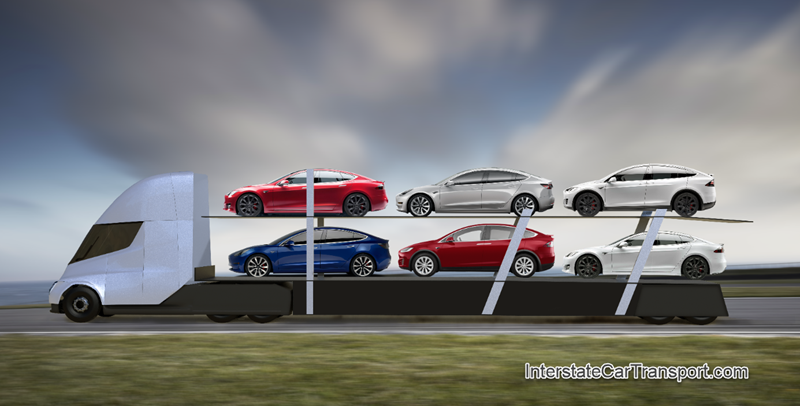
Improving Semi Safety
When shipping vehicles, companies need their products to reach their customers in perfect condition. Since the Tesla Semi Car Hauler offers impeccable safety features, manufactures should know that their cars will be completely safe on the carrier. Any damage or even minor scratches are one less thing for car manufacturers to worry about.
Reducing Car Shipping Costs
The Tesla Semi Truck has a high initial investment. The base model of this truck is already costlier than the average diesel truck, and we still haven’t added trailer and battery pack costs. However, the all-electric Semi poses significant long-term cost benefits when compared to its diesel counterparts.
First off, the Tesla Semi will require very little upkeep because there’s no transmission system or engine, and it’ll also have a longer life than the diesel truck.
The all-electric heavy-duty truck will also cost a lot less to operate. According to Tesla, for every 1 million miles the Semi travels, drivers can save nearly $200,000 in fuel expenses.
Future Innovations
With such hype around the Tesla Semi truck and so many orders pouring in already, no doubt this vehicle will revolutionize the car shipping industry. But that’s just for the near future. What about further down the line, when companies require a sleeping area within the cabin for the long haul drivers?Tesla says it’s ready to extend the cabin area to accommodate a sleeper, along with adjusting the low-lying battery pack accordingly.
All in all, the Tesla Semi shows a favorable future in the car shipping industry. However, all these benefits are only possible if Tesla overcomes some elementary technology challenges and lives up to its claims for producing the all-electric semi.
